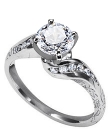Top Sellers
14K Yellow Gold 2 mm Half Round Wedding Band

14K White Gold Engraved Engagement Ring with Round Channel Set Diamond Side Stones (.20 ct. tw.)

14K White Gold 2 mm Cathedral Solitaire Engagement Ring

14K White Gold Halo Engagement Ring with Round Diamonds (.52 ct. tw.)

Testimonials
I'LL BE COUNTING ON YOU AGAIN...The diamond necklace I gave to my wife Karen for our anniversary was more beautiful than I had hoped. She loved it. Thank you so much for making our special day even more special.
Sincerely,
Ray M.
The 4 C's - Diamond Cut
|
The cut of a diamond is especially important because it has the most effect on the fire, or brilliance. A poor cut will make the diamond look dull even with excellent color and clarity. We only carry the higher diamond cut qualities so that you don't have to worry about picking a poorly cut diamond. Nature dictates the characteristics of color, clarity and carat, while humans directly influence the diamond cut. Cut refers to the angles and proportions (not diamond shape) a skilled craftsman creates in transforming a rough diamond into a polished diamond. A well cut diamond will internally reflect light from one mirror-like facet to another, dispersing and reflecting it through the top of the stone. This results in a display of fire or brilliance in the diamond. The cutter must polish tiny surfaces known as facets onto the rough diamond. This diamond cutting process also creates the diamond parts known as the crown, culet, table, girdle and pavilion. More About Diamonds: Ideal Cut Diamond - Nearly all light that enters the stone is reflected out of the top, designed to maximize brilliance. Symmetry and Polish
Diameter: The width of the diamond as measured through the girdle. Table: The top surface (largest facet) of a diamond that extends from the girdle. Crown: The upper facets of the diamond, above the girdle, leading to the table or top of the diamond. Girdle: The band around the widest part of a diamond. Pavilion: The bottom portion of a diamond extending from the girdle to the culet, sometimes referred to as the base. Also called the bottom half. Culet: The facet at the tip (bottom) of a gemstone. The preferred culet is not visible with the unaided eye (graded "medium" or "none"). Depth: The height of a gemstone measured from the culet to the table. Which Diamond Cut Should I Buy?
They reflect nearly all of the light that enters the stone and are designed to maximize brilliance. Very Good cut:
Light is reflected from one facet to another before shining through the top of the diamond. Good cut:
Light escapes through the opposite side of the pavilion, losing sparkle and brilliance. Fair & Poor cut:
Expert Guidance Use the links below to learn more about diamonds and the 4 C's:
Now that you’ve learned all about diamonds; use your knowledge to shop for your perfect diamond engagement ring. |

 Diamond Cut - Why it's Important
Diamond Cut - Why it's Important Good Proportions are Key
Good Proportions are Key



